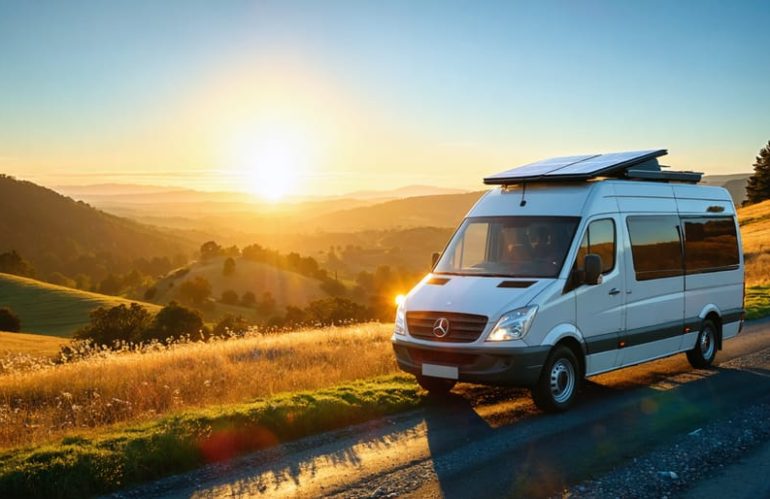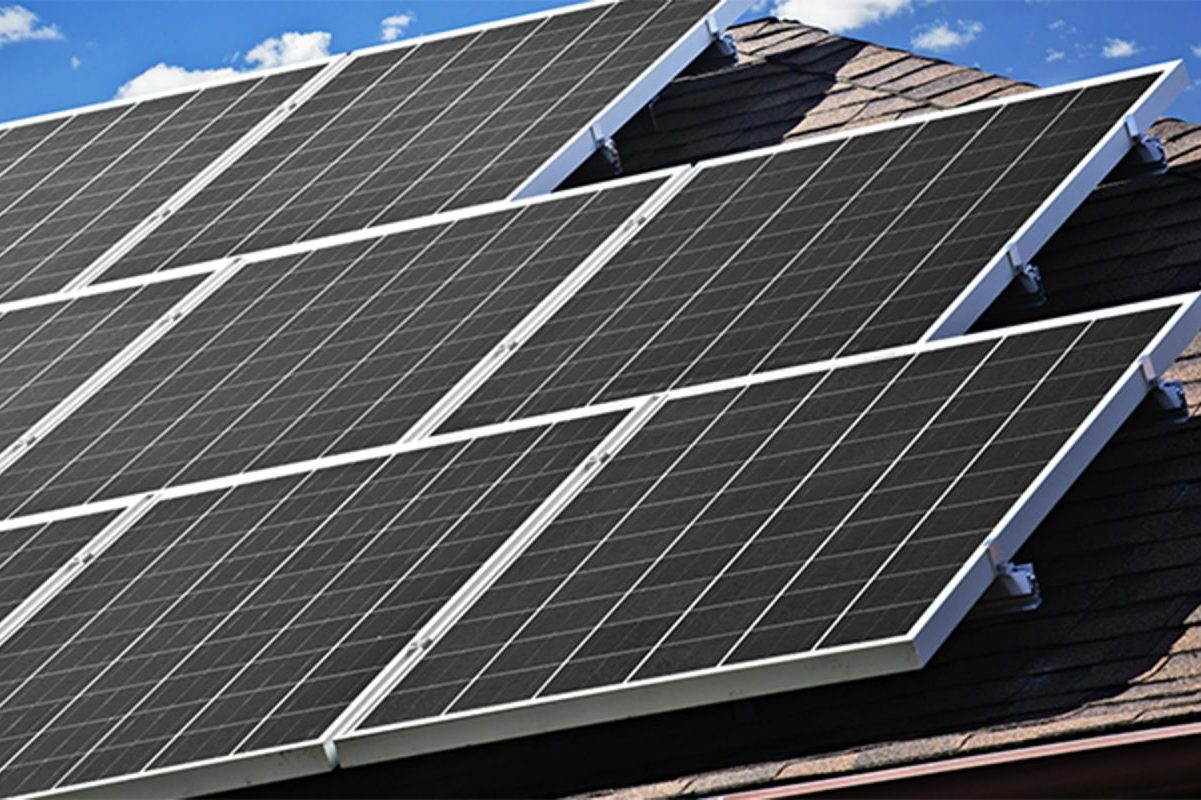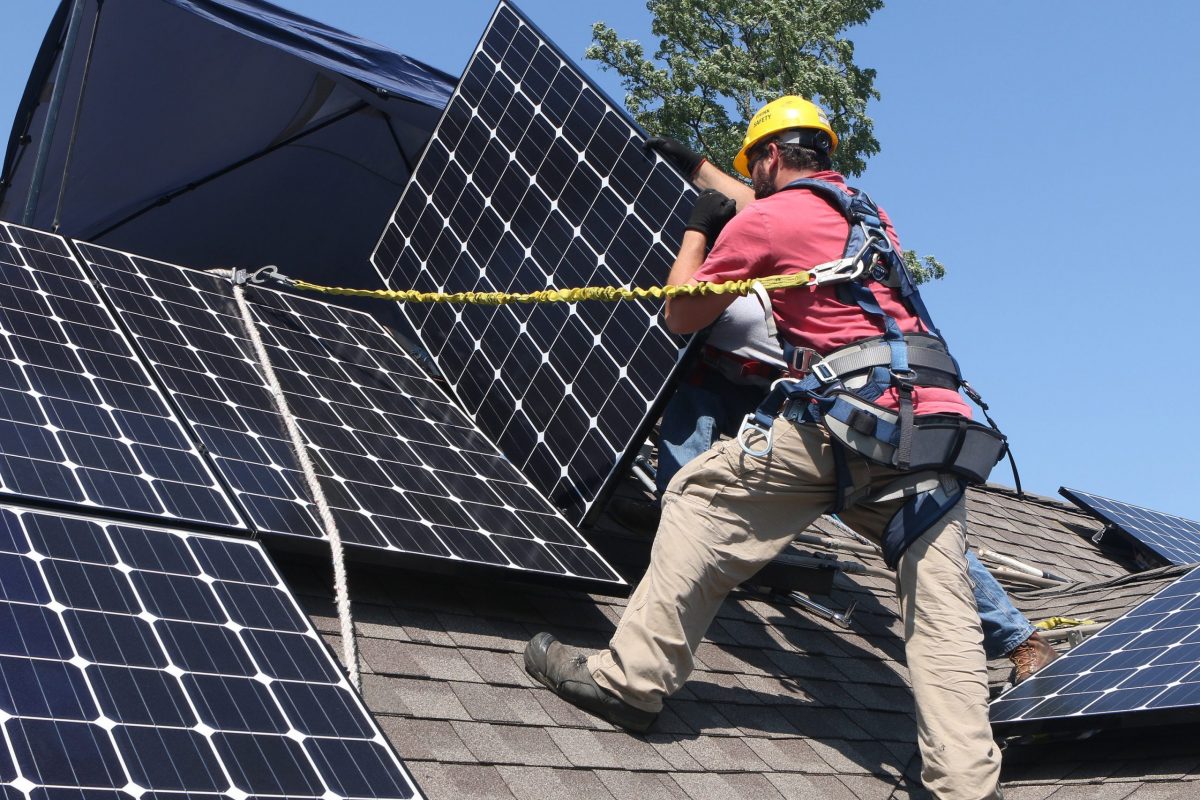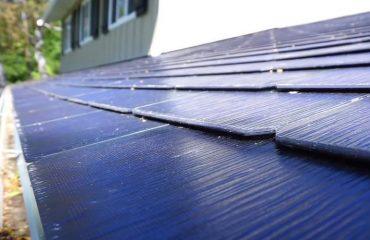Solar-powered vans represent a groundbreaking fusion of sustainable transportation and modern technology, offering a glimpse into the future of mobile living and eco-friendly travel. These innovative vehicles harness the sun’s endless energy through advanced photovoltaic panels mounted on their roofs, transforming ordinary vans into self-sufficient powerhouses on wheels.
As fuel prices soar and environmental consciousness grows, solar-powered vans have emerged as a practical solution for both weekend adventurers and full-time nomads. These vehicles don’t just promise freedom from traditional fuel dependencies; they deliver a revolutionary approach to mobile living that aligns perfectly with our planet’s urgent need for sustainable transportation alternatives.
Imagine driving across country while powering your essential appliances, work equipment, and living amenities using nothing but clean, renewable solar energy. From compact camping conversions to fully equipped mobile offices, solar-powered vans are reshaping how we think about vehicle functionality and energy independence.
Whether you’re an eco-conscious traveler, a remote worker seeking mobility, or simply curious about sustainable transportation options, solar-powered vans offer an exciting glimpse into a future where adventure and environmental responsibility go hand in hand.
How Solar-Powered Vans Actually Work
Solar Panel Integration
Modern solar-powered vans employ sophisticated solar power integration techniques that maximize energy collection while maintaining the vehicle’s aerodynamics. Most installations feature flexible solar panels that conform to the van’s curved roof, reducing wind resistance and maintaining the vehicle’s original profile. These panels are typically mounted using specialized brackets and marine-grade adhesive, ensuring a secure fit that withstands highway speeds and various weather conditions.
The most common setup includes 2-4 panels arranged strategically across the roof, with careful consideration given to avoid shadows from roof vents, antennas, or air conditioning units. Wiring is concealed within the van’s walls and connected to a charge controller, which regulates power flow to the battery bank. Some advanced designs incorporate bifacial panels that can capture reflected light from below, increasing energy production.
Many modern conversions also feature removable side panels that can be deployed while parked, significantly expanding the solar collection area. These supplementary panels can be stored inside the van during transit, offering flexibility for different energy needs. The integration process typically includes reinforcing the roof structure to support the added weight and installing weatherproof cable entry points to prevent leaks.
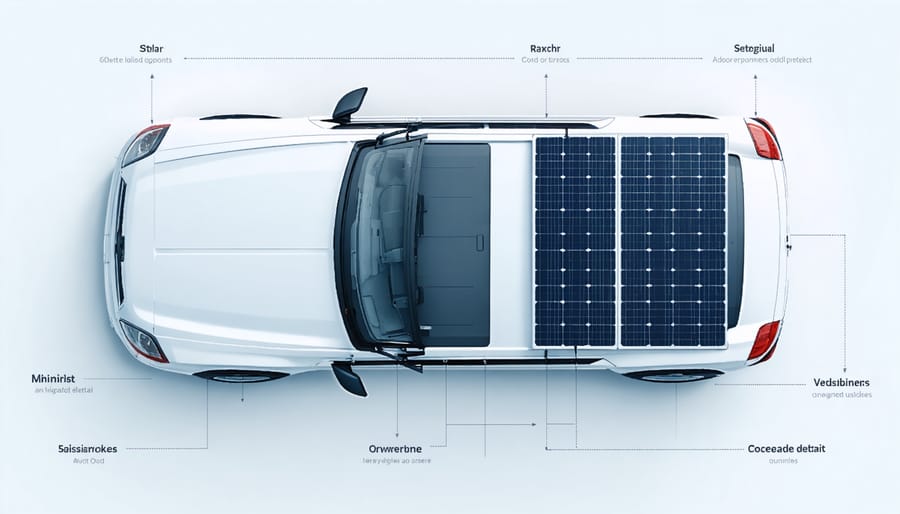
Power Storage and Management
At the heart of every solar-powered van lies a sophisticated battery system that stores and manages the harvested solar energy. Most modern setups utilize lithium-ion batteries, which offer an excellent balance of capacity, weight, and longevity. These batteries typically range from 200Ah to 600Ah, providing enough power to run essential appliances and electronics for several days, even with limited sunlight.
Advanced solar power management systems monitor energy flow, protect batteries from overcharging, and optimize power distribution. Many vans incorporate a dual-battery setup, with one dedicated to the vehicle’s starting system and another for living space power needs.
Smart inverters convert the stored DC power to AC power, making it possible to use standard household appliances. Most systems include built-in safety features like automatic shut-offs and surge protection. Energy monitoring displays give real-time information about power generation, consumption, and battery levels, helping users manage their energy use effectively.
To maximize efficiency, many van owners combine their solar setup with energy-efficient appliances and LED lighting, creating a sustainable power ecosystem that supports comfortable off-grid living while minimizing environmental impact.
Real-World Benefits of Solar-Powered Vans
Cost Savings Over Time
Converting your conventional van to a solar-powered system can lead to substantial solar power cost savings over time. While the initial investment might range from $2,000 to $6,000 depending on system size and components, the long-term financial benefits are impressive. Most van owners report breaking even on their solar investment within 3-5 years of installation.
The most immediate savings come from eliminated fuel costs for powering electronics and appliances. Traditional van owners typically spend $50-100 monthly on generator fuel and campground electrical hookups. With a solar system, these costs disappear entirely. For those living or working full-time in their vans, this can amount to over $1,000 in annual savings.
Maintenance costs are another area where solar-powered vans shine. Unlike generators that require regular servicing, solar panels need minimal maintenance beyond occasional cleaning. Most quality solar systems come with 25-year warranties, promising decades of reliable service with virtually no additional costs.
The resale value of solar-equipped vans tends to be 10-15% higher than conventional models, making it a smart long-term investment. Additionally, many states offer tax incentives and rebates for solar vehicle modifications, further reducing the initial investment cost and accelerating the return on investment timeline.
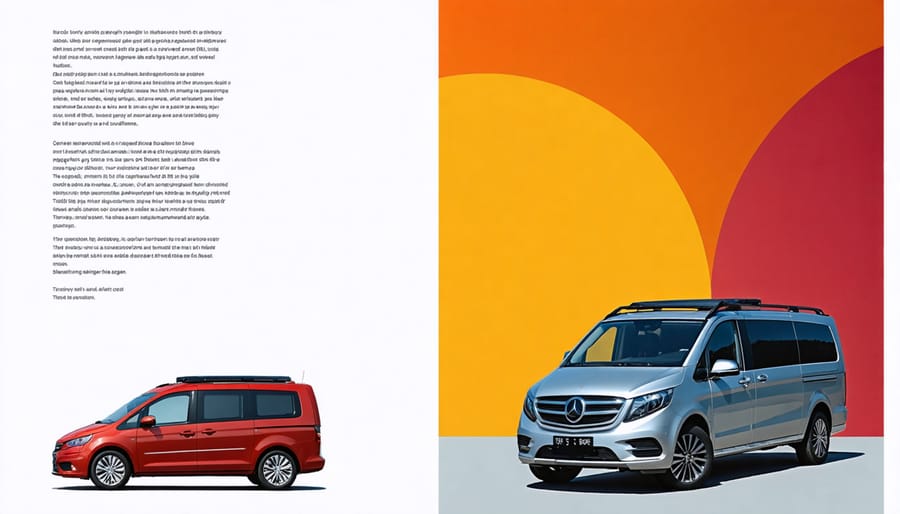
Environmental Impact
Solar-powered vans represent a significant leap forward in sustainable transportation, offering a remarkable reduction in carbon emissions compared to traditional fuel-powered vehicles. When properly equipped with solar panels and utilizing optimal solar energy efficiency systems, these vehicles can reduce their carbon footprint by up to 90% over their lifetime.
The environmental benefits extend beyond just reducing emissions. By harnessing solar power, these vans eliminate the need for frequent fuel stops, reducing the demand for fossil fuels and the associated environmental impacts of oil extraction and transportation. A typical solar-powered van can prevent approximately 2.5 tons of CO2 emissions annually – equivalent to planting over 40 trees.
These vehicles also contribute to cleaner air quality in urban areas, as they produce zero direct emissions during operation. This is particularly important in cities where air pollution from traditional vehicles poses significant health risks. Additionally, the solar panels used in these vans are increasingly manufactured using sustainable practices, and many components are recyclable at the end of their life cycle.
The adoption of solar-powered vans also helps promote wider acceptance of renewable energy solutions, encouraging others to consider sustainable transportation options. As more people embrace this technology, the collective impact on reducing greenhouse gas emissions becomes increasingly significant.
Current Market Options and Innovation
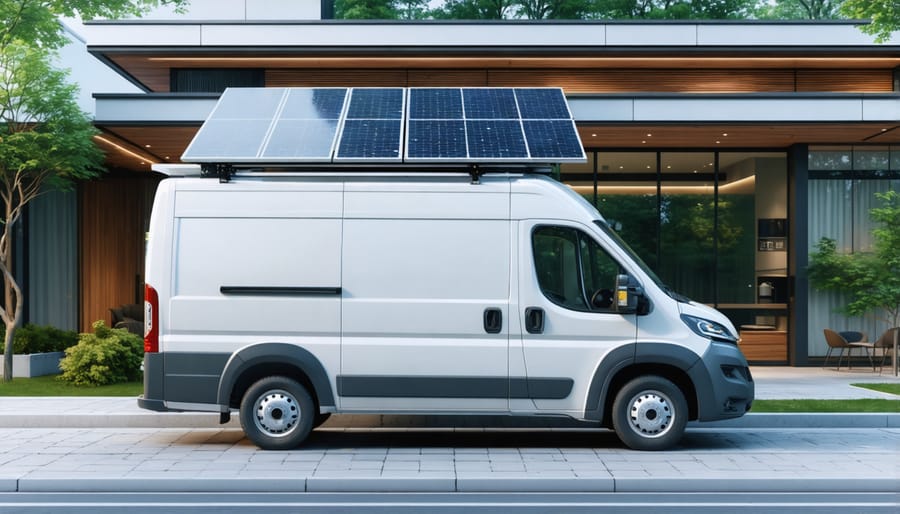
Commercial Solutions
Several established manufacturers now offer solar-powered van solutions for businesses looking to reduce their carbon footprint and operating costs. Mercedes-Benz has introduced their eSprinter van model with integrated solar panels, capable of extending the vehicle’s range by up to 20 miles per day through solar charging. The Ford E-Transit Custom features an optional solar roof system that powers auxiliary systems like refrigeration units and tools.
For smaller businesses, companies like Lightning eMotors specialize in converting existing commercial vans to solar-electric hybrids. These conversions can be customized based on specific business needs, from delivery services to mobile workshops. Brightdrop, backed by General Motors, offers purpose-built electric delivery vans with solar-panel options that can help maintain battery charge during stops.
Several startups are also making waves in this space. Sono Motors has developed the Sion van, featuring solar cells integrated into the body panels, while Solar Electric Vehicle Company (SEV) offers retrofit solutions for existing commercial fleet vehicles. These options typically include smart energy management systems that optimize power usage between solar generation and battery storage.
Most commercial solutions come with fleet management software, allowing businesses to track energy production, usage, and savings in real-time.
DIY Conversion Possibilities
Converting your existing van to solar power is a rewarding DIY project that can transform your vehicle into an eco-friendly adventure machine. The basic conversion process involves installing solar panels on the roof, connecting them to a charge controller, adding deep-cycle batteries for storage, and installing an inverter to convert DC power to AC power for your appliances.
Most vans can accommodate 200-400 watts of solar panels on their roof, which is typically sufficient to power essential electronics, lights, and small appliances. The installation process usually takes 2-3 days for someone with basic electrical knowledge, though more complex setups might require professional assistance.
Key components needed for a DIY solar conversion include:
– Rigid or flexible solar panels
– Solar charge controller
– Deep-cycle batteries
– Power inverter
– Mounting hardware
– Wiring and fuses
Before starting your conversion, carefully assess your power needs and available roof space. Flexible solar panels are often preferred for van installations as they’re lighter and more aerodynamic, though slightly less efficient than rigid panels. Consider starting with a basic setup that you can expand later as your needs grow.
Remember to include proper ventilation for batteries and ensure all connections are weatherproof for safety and longevity.
Practical Considerations Before Making the Switch
Before diving into the solar van lifestyle, several key factors deserve careful consideration. First, assess your typical energy consumption needs – from basic electronics to climate control systems. A good starting point is listing all your essential appliances and their power requirements to ensure your solar setup can handle the load.
Available roof space is crucial, as it determines how many solar panels you can install. A typical van roof can accommodate 2-4 panels, but factors like roof racks, vents, or AC units may limit this space. Consider whether your intended travel routes receive adequate sunlight throughout the year, as this directly impacts system efficiency.
Budget planning should account for not just the initial installation costs, but also maintenance and potential upgrades. While solar equipment prices have decreased significantly, quality components still require substantial investment. Factor in professional installation unless you’re confident in your DIY skills.
Storage capacity is another vital consideration. Battery banks need dedicated space, and their weight affects vehicle handling and fuel efficiency. Modern lithium batteries offer better performance but come at a higher cost than traditional lead-acid alternatives.
Climate considerations play a significant role. Extreme temperatures can affect both solar panel efficiency and battery performance. If you plan to travel in varied weather conditions, ensure your system includes appropriate temperature management solutions.
Don’t forget about parking and security. Solar panels can make your van more conspicuous, and some urban areas have height restrictions that might affect rooftop installations. Consider removable or flexible panels if stealth camping is important to you.
Lastly, research local regulations regarding solar installations on vehicles. Some jurisdictions have specific requirements for mobile solar systems, and understanding these beforehand can prevent future complications.
As we look toward a more sustainable future, solar-powered vans represent a significant leap forward in eco-friendly transportation. These innovative vehicles not only reduce our carbon footprint but also offer practical solutions for both personal and commercial use. With advancing technology driving down costs and improving efficiency, solar-powered vans are becoming increasingly viable options for environmentally conscious consumers.
The potential impact of widespread solar van adoption is substantial. From reducing greenhouse gas emissions to lowering operating costs for businesses, these vehicles could revolutionize how we think about transportation. As battery technology continues to improve and solar panel efficiency increases, we can expect to see longer ranges, faster charging times, and more affordable options entering the market.
For those considering making the switch, now is an excellent time to explore solar-powered van options. The combination of government incentives, decreasing technology costs, and growing infrastructure support makes the transition more accessible than ever. Whether you’re a business owner looking to green your fleet or an individual seeking a sustainable travel solution, solar-powered vans offer a practical path forward.
Take the first step toward sustainable transportation by researching available models, consulting with solar vehicle specialists, and calculating potential savings. By embracing this technology, you’ll not only contribute to environmental conservation but also position yourself at the forefront of the clean energy revolution in transportation.

